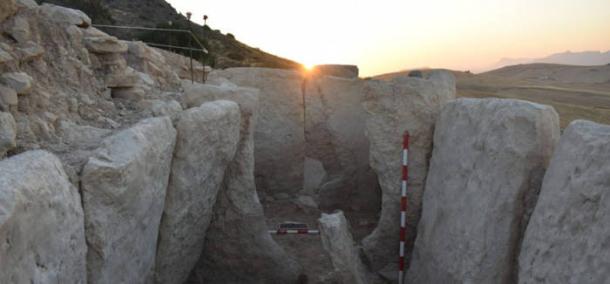Science
Archaeologists Discover 5,000-Year-Old Dolmen in Southern Spain

Archaeologists from the University of Cádiz have unearthed a significant prehistoric tomb in Teba, a town located in the province of Málaga, Spain. The discovery, known as “Dolmen I,” measures an impressive 13 meters (approximately 42.5 feet) in length and is believed to date back over 5,000 years. This find adds to the rich archaeological heritage of Andalusia and offers new insights into ancient burial practices during the Copper Age.
The excavation took place at the La Lentejuela necropolis, where researchers have revealed a megalithic tomb that is remarkably well-preserved. The structure features complex interior compartments, suggesting advanced architectural planning by the communities that constructed it. The meticulous nature of the excavation, led by Dr. Eduardo Vijande and Dr. Serafín Becerra, was part of a broader project titled “Monumentality, Time and Society: The Megalithic Phenomenon at the La Lentejuela Necropolis.” Over four excavation campaigns, the team worked diligently to uncover this ancient monument, revealing its intricate details stone by stone.
The discovery of Dolmen I is considered one of the most monumental achievements of Neolithic engineering in the region. The tomb’s construction techniques and layout provide valuable information about the social and cultural dynamics of Copper Age societies. The researchers are particularly excited about the potential implications of the dolmen for understanding burial customs and community organization during this period.
In addition to the architectural significance, the dolmen’s exceptional preservation has surprised the archaeological community. The almost complete state of the tomb allows for detailed study, giving researchers a clearer picture of the practices and beliefs of the people who lived in Southern Spain thousands of years ago.
As excavations continue, Dr. Vijande and Dr. Becerra hope to uncover more artifacts and information that will shed light on the lives of those who constructed Dolmen I. The ongoing research at the La Lentejuela necropolis promises to enhance our understanding of early human societies in the Iberian Peninsula and their monumental legacy.
This discovery not only enriches the archaeological narrative of Southern Spain but also emphasizes the importance of continued research in understanding the complexities of human history. The findings from Dolmen I will certainly be a focal point for future studies in prehistoric archaeology, contributing to the broader discourse on the development of early civilizations.
-

 Top Stories3 months ago
Top Stories3 months agoTributes Surge for 9-Year-Old Leon Briody After Cancer Battle
-

 Entertainment4 months ago
Entertainment4 months agoAimee Osbourne Joins Family for Emotional Tribute to Ozzy
-

 Politics4 months ago
Politics4 months agoDanny Healy-Rae Considers Complaint After Altercation with Garda
-

 Top Stories4 months ago
Top Stories4 months agoIreland Enjoys Summer Heat as Hurricane Erin Approaches Atlantic
-

 World5 months ago
World5 months agoHawaii Commemorates 80 Years Since Hiroshima Bombing with Ceremony
-

 Top Stories3 months ago
Top Stories3 months agoNewcastle West Woman Patricia Foley Found Safe After Urgent Search
-

 Top Stories5 months ago
Top Stories5 months agoFianna Fáil TDs Urgently Consider Maire Geoghegan-Quinn for Presidency
-

 World5 months ago
World5 months agoCouple Convicted of Murdering Two-Year-Old Grandson in Wales
-

 World5 months ago
World5 months agoGaza Aid Distribution Tragedy: 20 Killed Amid Ongoing Violence
-

 World5 months ago
World5 months agoAristocrat Constance Marten and Partner Convicted of Infant Murder
-

 Top Stories4 months ago
Top Stories4 months agoClimbing Errigal: A Must-Do Summer Adventure in Donegal
-

 Top Stories4 months ago
Top Stories4 months agoHike Donegal’s Errigal Mountain NOW for Unforgettable Summer Views









